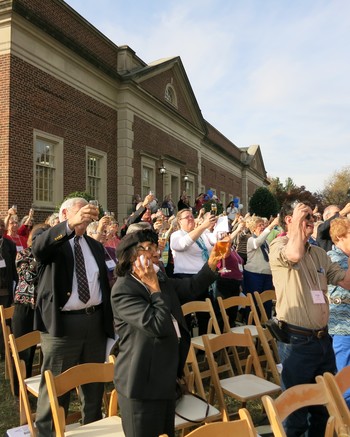In 1907, Annie Wilson – a young Presbyterian woman who desired to serve the church as an overseas missionary – sought admission to Union Theological Seminary here. Though there was no provision for women students, much less non-ministerial candidate students, the seminary allowed Wilson to attend classes … without credit.
Soon, Wilson was joined by 13 of her friends and by 1914 – with demand for theological education for laypersons, particularly women, mushrooming – the (General) Assembly Training School (ATS) was founded downtown and eventually occupied a campus across Brook Road from the Union Seminary campus.
In 1959, the Presbyterian Church’s flagship institution for training Christian educators was renamed Presbyterian School of Christian Education (PSCE). After teaching generations of church educators (and ministers) the school “federated” with Union and in the late 2000s became part of newly-renamed Union Presbyterian Seminary (UPSem).
On Nov. 4, during the Nov. 2-5 centennial celebration of ATS/PSCE here, an historical marker was dedicated on the former PSCE campus near historic Lingle Hall. It was the 2,400th historical marker authorized by the State of Virginia. More than 300 ATS/PSCE/UPSem people attended, including city and state officials.
“The real VIP today is Annie Wilson,” said former PSCE President Wayne Boulton, who headed the school from 1992-1997. “One hundred seven years ago, lifted by the Spirit of God, Annie gave birth to as dazzling a creation as we have ever seen.”

Richmond Mayor Dwight C. Jones. —Photo by Jerry L. Van Marter
Richmond Mayor Dwight C. Jones, a Baptist minister who attended classes at PSCE while a student at the divinity school of historically-black Virginia Union University, praised the legacy of ATS/PSCE, particularly its record of service in the black communities of segregated Richmond in the years before racial integration took hold in the south.
“I’m in public service because of my commitment to social justice,” Jones said, acknowledging the role institutions such as PSCE played in de-segregating Richmond. The school had sent students into “field work” placements in the schools, factories and community centers of the city throughout the decades.
Boulton termed this kind of service “striding into God’s future” and said it is the enduring legacy of ATS/PSCE. “And when we have the courage to stride into God’s future,” he said, “we are ALL Annie’s children.”
Participants symbolically took those strides as they concluded the historical marker dedication by “crossing the brook” – crossing Brook Road from the former ATS/PSCE campus to the current Union Presbyterian Seminary campus – for the benedictory.

Historical marker. —Photo by Jerry L. Van Marter
The full text of the ATS/PSCE historical marker:
Appointed to Serve
Founded by the Presbyterian Church U.S. in 1914,
the Assembly’s Training School was the church’s first coeducational
“lay workers” school. Through the school, women barred
from seminary received a theological education.
Among the earliest faculty were women who taught social welfare,
Christian ethics, and practicum at the 17th Street Mission,
Richmond factories, and parts of Appalachia.
Students and professors broke gender and racial boundaries,
even creating an integrated roller rink and housing participants
of the Poor People’s March in the 1960s.
Renamed the Presbyterian School of Christian Education in 1959,
the school is now part of Union Presbyterian Seminary.

